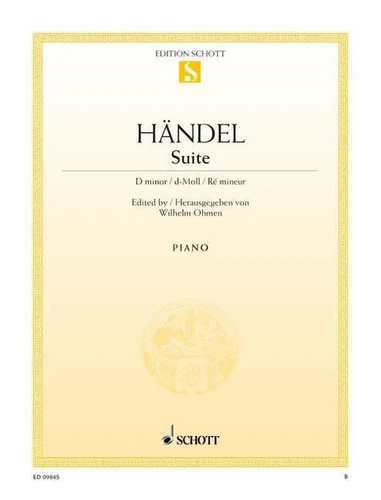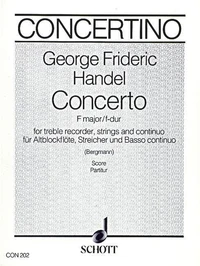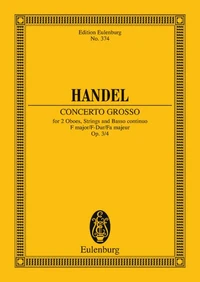Suite en ré mineur. HWV 437 (HHA II/4 - Walsh 1733 No. 4). piano. Edition séparée.
Par :Formats :
- Paiement en ligne :
- Livraison à domicile ou en point Mondial Relay indisponible
- Retrait Click and Collect en magasin gratuit
- Réservation en ligne avec paiement en magasin :
- Indisponible pour réserver et payer en magasin
- Nombre de pages12
- Poids0.062 kg
- Dimensions23,1 cm × 30,3 cm × 0,0 cm
- ISBNM-001-15226-2
- EAN9790001152266
- Date de parution01/01/2000
- CollectionEdition Schott - Single Editio
- ÉditeurSchott
- EditeurWilhelm Ohmen
Résumé
The number of Georg Friedrich Handel's works for piano is reasonably small, compared to that by his great contemporary Johann Sebastian Bach. He was an excellent harpsichordist and improviser. The works that can be called real masterpieces are his eight major suites and the six major fugues. Characteristic stylistic features of Handel's piano works are the change of homophonic and polyphonic settings and solemn processional rhythms.
In contrast to Bach who also wrote compositions for the clavichord, his works are intended for the harpsichord. This also applies to the current Suite in D minor which was published in the second collection of small suites in 1733. Clearly structured, with its pleasant allemande and the familiar simple chordal sarabande, it classifies as easy to moderately difficult and can be easily mastered by the piano pupil and music lover.
Instrumentation : piano HWV 437 (HHA II/4 - Walsh 1733 No. 4)
In contrast to Bach who also wrote compositions for the clavichord, his works are intended for the harpsichord. This also applies to the current Suite in D minor which was published in the second collection of small suites in 1733. Clearly structured, with its pleasant allemande and the familiar simple chordal sarabande, it classifies as easy to moderately difficult and can be easily mastered by the piano pupil and music lover.
Instrumentation : piano HWV 437 (HHA II/4 - Walsh 1733 No. 4)
The number of Georg Friedrich Handel's works for piano is reasonably small, compared to that by his great contemporary Johann Sebastian Bach. He was an excellent harpsichordist and improviser. The works that can be called real masterpieces are his eight major suites and the six major fugues. Characteristic stylistic features of Handel's piano works are the change of homophonic and polyphonic settings and solemn processional rhythms.
In contrast to Bach who also wrote compositions for the clavichord, his works are intended for the harpsichord. This also applies to the current Suite in D minor which was published in the second collection of small suites in 1733. Clearly structured, with its pleasant allemande and the familiar simple chordal sarabande, it classifies as easy to moderately difficult and can be easily mastered by the piano pupil and music lover.
Instrumentation : piano HWV 437 (HHA II/4 - Walsh 1733 No. 4)
In contrast to Bach who also wrote compositions for the clavichord, his works are intended for the harpsichord. This also applies to the current Suite in D minor which was published in the second collection of small suites in 1733. Clearly structured, with its pleasant allemande and the familiar simple chordal sarabande, it classifies as easy to moderately difficult and can be easily mastered by the piano pupil and music lover.
Instrumentation : piano HWV 437 (HHA II/4 - Walsh 1733 No. 4)



















